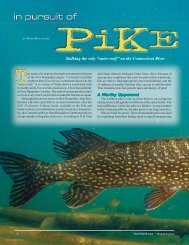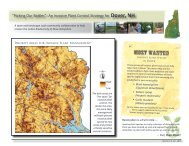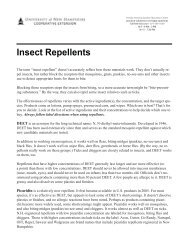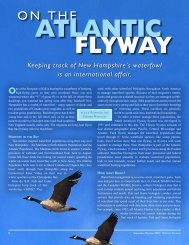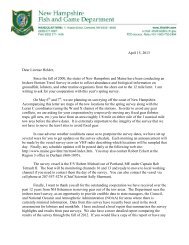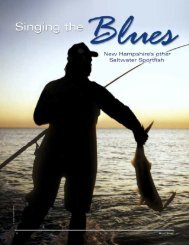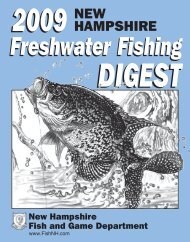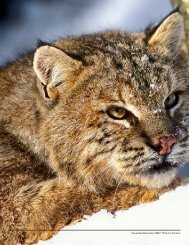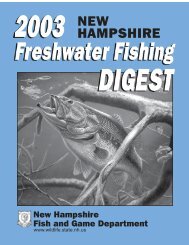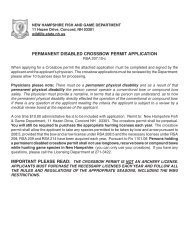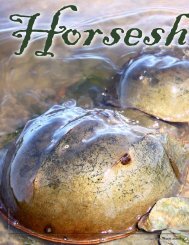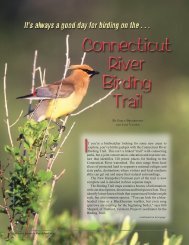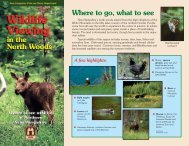A Multitude of Moths - New Hampshire Fish and Game Department
A Multitude of Moths - New Hampshire Fish and Game Department
A Multitude of Moths - New Hampshire Fish and Game Department
You also want an ePaper? Increase the reach of your titles
YUMPU automatically turns print PDFs into web optimized ePapers that Google loves.
© ERIC ALDRICH PHOTO© VICTOR YOUNG PHOTO© VICTOR YOUNG PHOTOJeff Lougee <strong>of</strong> The NatureConservancy sometimes collects asmany as 200 moth specimens in asingle night.Betterunderst<strong>and</strong>ing<strong>of</strong> moths will leadto better habitatmanagement.Cecropia mothPainted lady butterflycontinued from previous pagebeautiful, like the luna moth. Andsome <strong>of</strong> them are tiny <strong>and</strong> delicate<strong>and</strong> colorful.”The most beautiful, if you askCh<strong>and</strong>ler, are the so-called micros —so small you could fit four or five <strong>of</strong>them on a penny. Under a microscope,their splendor shines. B<strong>and</strong>s <strong>of</strong>gold or silver. Patches <strong>of</strong> iridescentblue. Verydelicate, brilliant<strong>and</strong> littleunderstood.In fact, manyentomologistsdon’tbother collectingthem; they’re to<strong>of</strong>ragile, too hard to identify <strong>and</strong> too hard to preparefor collections.As curator <strong>of</strong> UNH’s insect collection, Ch<strong>and</strong>lerhas tediously identified <strong>and</strong> mounted hundreds<strong>of</strong> moths. Within the collection’s 700,000 insectspecimens — from beetles to flies — are some2,000 moth species. These are moths, mind you,not butterflies, which occupy a much smallernumber <strong>of</strong> nearby drawers.Moth orButterfly?Three micro mothson a dime.While there’s no foolpro<strong>of</strong> rule fordistinguishing moths <strong>and</strong> butterflies,both members <strong>of</strong> the orderLepidoptera, here are some clues:• <strong>Moths</strong> tend to rest with wings flat,while butterflies, with some exceptions,rest with wings folded upwardsover their back.• <strong>Moths</strong> tend to be nocturnal or dusk/dawn flyers, while most butterflies flyduring the day.• All moths have a bristle or bunch <strong>of</strong>bristles, called a frenulum, lockingthe forewing <strong>and</strong> hindwing together;butterflies don’t have this feature.• Most moths have tapering, featheryor hairlike antennae. Butterflies havea knob at the tip <strong>of</strong> the antennae.© ERIC ALDRICH PHOTOFrom Egg to MothButterflies <strong>and</strong> moths share a fairly similar lifehistory. Both go through four stages: egg, pupa,larva (or caterpillar) <strong>and</strong> adult. On reaching itslarval stage, a moth caterpillar will find a quietplace where it will make the transition to an adult.Some species spin a silk cocoon attached to abranch. Others make the transition underground,or go inside a folded leaf. Inside, the caterpillarbecomes a pupa <strong>and</strong> its body transforms into a sort<strong>of</strong> soup. Its metamorphosis into a moth can takedays, weeks or even months, depending on thespecies.Once emerged, the adult moth has four wings:two on top called forewings <strong>and</strong> two “hind” wingsunderneath. Most adult moths live only two weeksor so; others a few days or a few months. Andwhile some will eat during this time, others willnot, focusing instead on reproducing <strong>and</strong> avoidingpredators. Once the female lays eggs, there’slittle else for her to do.Much <strong>of</strong> the moth’s role in the ecosystem —especially among <strong>New</strong> <strong>Hampshire</strong>’s species — isto eat, according to UNH’s Don Ch<strong>and</strong>ler. Only afew species here are pollinators. Most fill theirecological purpose as caterpillars ... eating <strong>and</strong>eating. They’re like little gardeners, he says. Eatingleaves <strong>and</strong> other pieces <strong>of</strong> plants stimulatesplants to grow. Other moth caterpillars help recyclethe soil by eating detritus.Habitats <strong>and</strong> <strong>Moths</strong>You can find moths virtually anywhere in <strong>New</strong><strong>Hampshire</strong>. Different habitats produce differentmoths, in both abundance <strong>and</strong> diversity. Oakforests, for instance, have a relatively huge variety<strong>of</strong> species <strong>and</strong> abundance <strong>of</strong> individual moths.Ch<strong>and</strong>ler has collected certain moths in theSeabrook s<strong>and</strong> dunes <strong>and</strong> others in silver mapleflood plain forests near Dalton. He’s collected232 species in Spruce Hole kettle bog near Durham.Some <strong>of</strong> the rarest moth species in the state arefound in the remnant pine barrens, such as thosein the Concord <strong>and</strong> Ossipee areas. According toDale Schweitzer, a <strong>New</strong> Jersey-based moth <strong>and</strong>butterfly expert with The Nature Conservancy,pine barrens (like those found from Maine throughthe Mid-Atlantic states) “are the habitat for global<strong>and</strong> regional moth rarities. Pitch pine/scrub oakbarrens are the place to look. There’s no otherhabitat that comes close to having the rarities.”In the Concord pine barrens, which is habitatfor the endangered Karner blue butterfly, Ch<strong>and</strong>lerhas collected some 578 moth species. N.H.<strong>Fish</strong> <strong>and</strong> <strong>Game</strong> has also done scientific monitor-16 September/October 2004 • WILDLIFE JOURNAL



